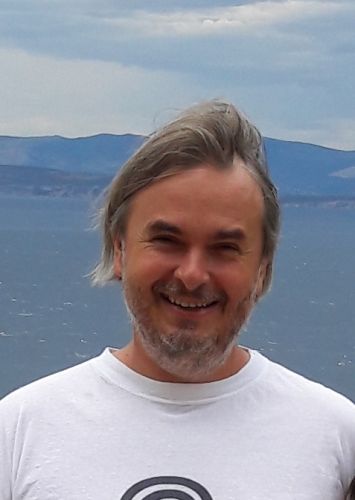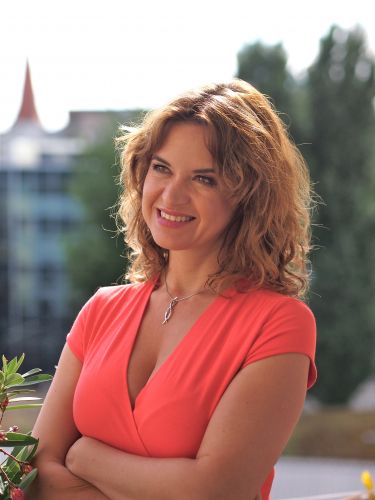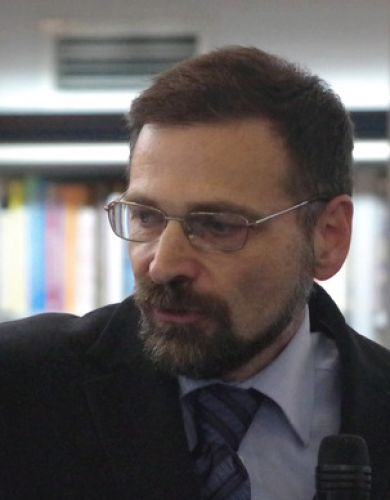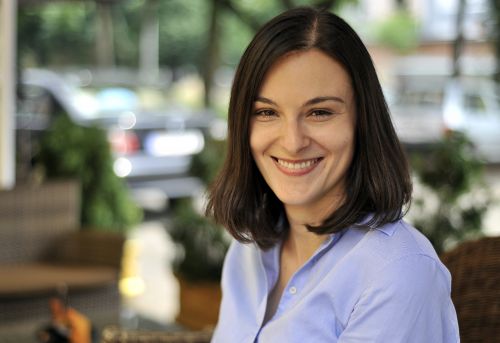The invited lectures that were given in 2021 are:
Prof. dr. sc. Marijan Herak: “Seismology as a multidisciplinary science – recent examples of studies of earthquakes near Zagreb and Petrinja in 2020/2021“
Prof. dr. sc. Vernesa Smolčić: “Evolution of galaxies through cosmic time”
Prof. dr. sc. Josip Tambača: „Mathematical modeling of stents“
Prof. dr. sc. Iva Tolić: “Mechanobiology of the mitotic spindle”
Prof. dr. sc. Iva Tolić: “Mechanobiology of the mitotic spindle”
Our bodies are built from around 100 trillion individual cells, each of which contains 46 chromosomes that carry our genetic material. This enormous number of cells originates from a single cell that is the product of fertilization of an egg with a sperm. Thus, cell division is one of the most fundamental processes in the living world. At the onset of division the cell assembles the mitotic spindle, a fascinating and complex micro-machine made of microtubules and the accompanying proteins. The microtubules move the chromosomes around and finally line them up in the middle of the spindle. When all chromosomes are ready, sister chromatids are moved apart towards the opposite spindle poles. The central question in this field of research is how the mitotic spindle manages to divide chromosomes into two equal sets without errors. Understanding how proper chromosome segregation is achieved in cells and how it is controlled will help to identify new strategies for prevention and treatment of diseases such as cancer and genetic disorders caused by chromosome segregation errors. By taking an interdisciplinary approach, in which we combine cell and molecular biology, molecular genetics, cutting-edge microscopy, laser microsurgery, computer science and theoretical physics, my group explores how the mitotic spindle self-assembles and how forces that move the chromosomes are generated.
Prof. dr. sc. Josip Tambača: “Mathematical modeling of stents“
A stent is a mesh that is placed in a narrowed or closed part of a blood vessel to keep the vessel open to restore normal blood flow. There are dozens of stents on the market with a very complex structure and of different sizes, geometries, and then mechanical properties. Testing and designing stents that will meet the prescribed mechanical constraints can be a very demanding task. However, there is a very efficient way for this task, and it is based on the use of a reliable and simple mathematical model. In this talk I will present the path to such a model, and emphasise opportunities it provides. Numerical approximation of the solution of the model allows us to build simulations that can lead us to different conclusions about the global properties of the stent without producing it. Moreover, the simulations allow us to go a step further and look for stents that are optimal in some sense. Thus, on the example of stents, I will approach the three cornerstones for new technologies: modeling, simulation and optimization.
Prof. dr. sc. Vernesa Smolčić: “Evolution of galaxies through cosmic time”
Understanding how galaxies form in the early universe and their subsequent evolution through cosmic time is a major goal of modern astrophysics. Panchromatic look-back sky surveys significantly advanced the field in the past decades, leading to a general understanding of galaxy evolution. In the talk I will go through the concepts and results of galaxy evolution studies.
Prof. dr. sc. Marijan Herak: “Seismology as a multidisciplinary science – recent examples of studies of earthquakes near Zagreb and Petrinja in 2020/2021”
Seismology is very young discipline which stands out among sciences by several traits (e.g. the extremely large range of amplitudes and periods of ground motion it studies). It also has three faces – the research one (physics of the Earth’s interior), the professional face (recording, locating and cataloguing earthquakes), and the one that deals with seismic hazard assessment and the ways to mitigate seismic risk. Related to these is its distinct multidisciplinarity and the need for close cooperation with various professions. Besides the expected physics and mathematics, there are also: geology, civil engineering, geodesy, but also professions such as history, linguistics or archiving.
In the lecture, I will look at how this collaboration materialized during the 2020/2021 earthquake series near Zagreb (ML = 5.5) and Petrinja (ML = 6.2). Joint research with geologists related to locating aftershocks and determining the causal fault will be described, as well as cooperation with colleague geodesists in interpreting the satellite radar measurements (InSAR). The research on the historical seismicity to quantify past important earthquakes that are important in earthquake hazard assessment will be also briefly discussed.
Prof. dr. sc. Josip Tambača

Prof. dr. sc. Josip Tambača is one of the world’s experts in mathematical modeling in biomedicine and a full professor at the Department of Mathematics, Faculty of Science, University of Zagreb. He is the winner of the Annual State Science Award in 2019 for scientific achievement in the field of natural sciences, field of mathematics, branch of applied mathematics and mathematical modeling, for six papers published in 2019 in top international scientific journals. The papers rigorously derive lower-dimensional models that describe the behavior of elastic bodies starting from the equations of a three-dimensional elastic body, with the interaction of two elastic structures of different thicknesses and with specifics such as poroelasticity and biodegradability of materials. The basic applications of these results are in biomedicine, such as a stent model with displacements in all three dimensions based on a one-dimensional model of a curved elastic rod or a model and simulation of blood flow through elastic vessels. In these papers, numerical methods for these models are proposed and the results of simulations are presented, including the application to four types of commercial stents. His specific field of scientific work is the theory of elasticity, especially mathematical justification and derivation of lower-dimensional models, as well as modeling and properties of the interaction of elastic bodies with fluid. He is currently working on optimal stent design, in an area where modeling, simulation and optimization are combined. He also won the 2001 State Science Award for Research Fellows. He has published over 50 scientific papers and is a leader and collaborator on numerous scientific projects. He was a guest on popular science shows Treći element and Prometej, and was the leader of the Mathematical Modeling workshop in the field of applied mathematics and statistics in the XV. Gymnasium in Zagreb. He has given numerous popular lectures, especially for high school students.
Prof. dr. sc. Iva Tolić

Prof. dr. sc. Iva Tolić is one of the world’s leading scientists in the field of cell division biophysics, a permanent scientific advisor at the Ruđer Bošković Institute and a full professor at the Department of Biology at the Faculty of Science, University of Zagreb. She received her PhD in 2002 from the University of Zagreb, and she pursued further scientific training at Harvard University in Boston, the Niels Bohr Institute in Copenhagen and the University of Florence. Since 2004 she has been the leader of the research group at the Max Planck Institute for Molecular Cell Biology and Genetics in Dresden, and since 2014 she has been the leader of the research group at the Ruđer Bošković Institute. In her interdisciplinary research, she combines molecular cell biology and genetics with state-of-the-art microscopy techniques. She is the author of over 90 scientific papers and has given more than 120 invited lectures in more than 15 different countries, and under her mentorship 11 doctoral students have received their doctorates. She is a member of the European Organization for Molecular Biology (EMBO) and an associate member of the Croatian Academy of Sciences and Arts (HAZU). For her outstanding scientific discoveries in the field of molecular cell biology, she received numerous awards such as the Order of Danica Hrvatska with the figure of Ruđer Bošković, the State Award for Science, the Influential Croatian Women Award, the Croatian Society of Biochemistry and Molecular Biology Award, the European Biophysical Association Medal and Award, the prize of the European Society for Microscopy and the Ignaz L. Lieben Prize of the Austrian Academy of Sciences (ÖAW), which is also called the Austrian Nobel Prize. She is the holder of numerous scientific projects, among which the most prestigious projects of the European Research Council (ERC) Consolidator and Synergy stand out, known as the “Scientific Oscars”.
Prof. dr. sc. Marijan Herak

Prof. dr. sc. Marijan Herak is a distinguished Croatian seismologist and full professor at the Department of Geophysics, Faculty of Science, University of Zagreb. He graduated in physics-geophysics in 1981, and received his master’s degree in 1985. He defended his doctoral dissertation in 1991 at the University of Zagreb. He trained scientifically in Germany, Italy, the USA and China. In his scientific work he deals with numerous aspects of seismology, with special emphasis on studies of seismicity in Croatia, research into the properties of the Earth’s interior, surface waves, earthquake quantification, historical seismology, earthquake statistics and work related to seismic hazard and threat assessment. He has published 83 papers in international peer-reviewed journals (Wos, Scopus, CC) and dozens of other papers, as well as many studies. According to Google Scholar, his works have been cited more than 2,000 times with an h-index of 27. He is also the author of computer programs for various seismic data analyses and the main author of the Croatian Seismic Hazard Map. He has organized a number of international conferences and workshops and participated in more than 20 international and domestic research projects (in about half of them in the role of principal investigator or leader of the Croatian team). The professor distinguished himself in the academic community by performing the duties of the head of the department and vice-dean of the Faculty of Science for International Cooperation for two terms, and he also served as the president of the University Council of Natural Sciences. He was the president of the Scientific Council for Remote Sensing of the Croatian Academy of Sciences and Arts (HAZU), as well as the editor-in-chief of the journal Geofizika. M. Herak is the Croatian representative in the European Seismological Commission and an associate member of the Croatian Academy of Sciences and Arts. In 2016, he was awarded the ‘Andrija Mohorovičić’ award of the University of Zagreb.
Prof. dr. sc. Vernesa Smolčić

Prof. dr. sc. Vernesa Smolčić is a world-renowned astrophysicist and full professor at the Department of Physics, Faculty of Science, University of Zagreb. She continued her studies in the USA, Germany and Australia, and after nine years of work and training at the best universities in the world, she returned to Croatia. Her research focuses on the formation and development of galaxies, she studies active galactic nuclei, radio galaxies and extragalactic star formation. She is a member of numerous international collaborations, and in some of them she holds leadership positions, such as in the Cosmic Evolution Survey (COSMOS) and The Ultimate XMM Extragalactic Survey. Among other things, she is the coordinator of the activities of the Faculty of Science related to the European Space Agency and a member of the Reference Group for Space (MSE). She has published over 140 scientific papers and received numerous awards for her work, such as the Ernst Patzer Award, Zagreb Woman of the Year 2014, Recognition of the Faculty Council of the Faculty of Science for significant scientific achievement and contribution to the reputation of the Faculty of Science, COSMO Scientist of the Year 2015, State Award for Science for 2017, Award of the Croatian Academy of Sciences and Arts for the highest scientific and artistic achievements in the Republic of Croatia for 2019 in the field of mathematical, physical and chemical sciences, and was included in the list of most successful people of generation 2013 by Forbes magazine. In addition to the prestigious ERC Starting Grant for the project “Constraining Stellar Mass and Supermassive Black Hole Growth through Cosmic Times: Paving the Way for the Next Generation Sky Surveys”, she has led numerous scientific projects. The professor is very active in popularizing science and runs a project called Astroučionica, a web platform intended for the popularization of astronomy. Astroučionica was created during the implementation of the ERC project in 2018 and has continued to grow since then. She is also the ambassador of the “Deep Above All” campaign of Jana’s natural mineral water.